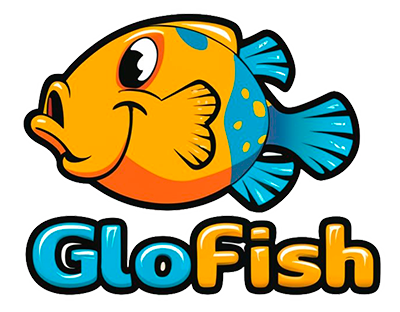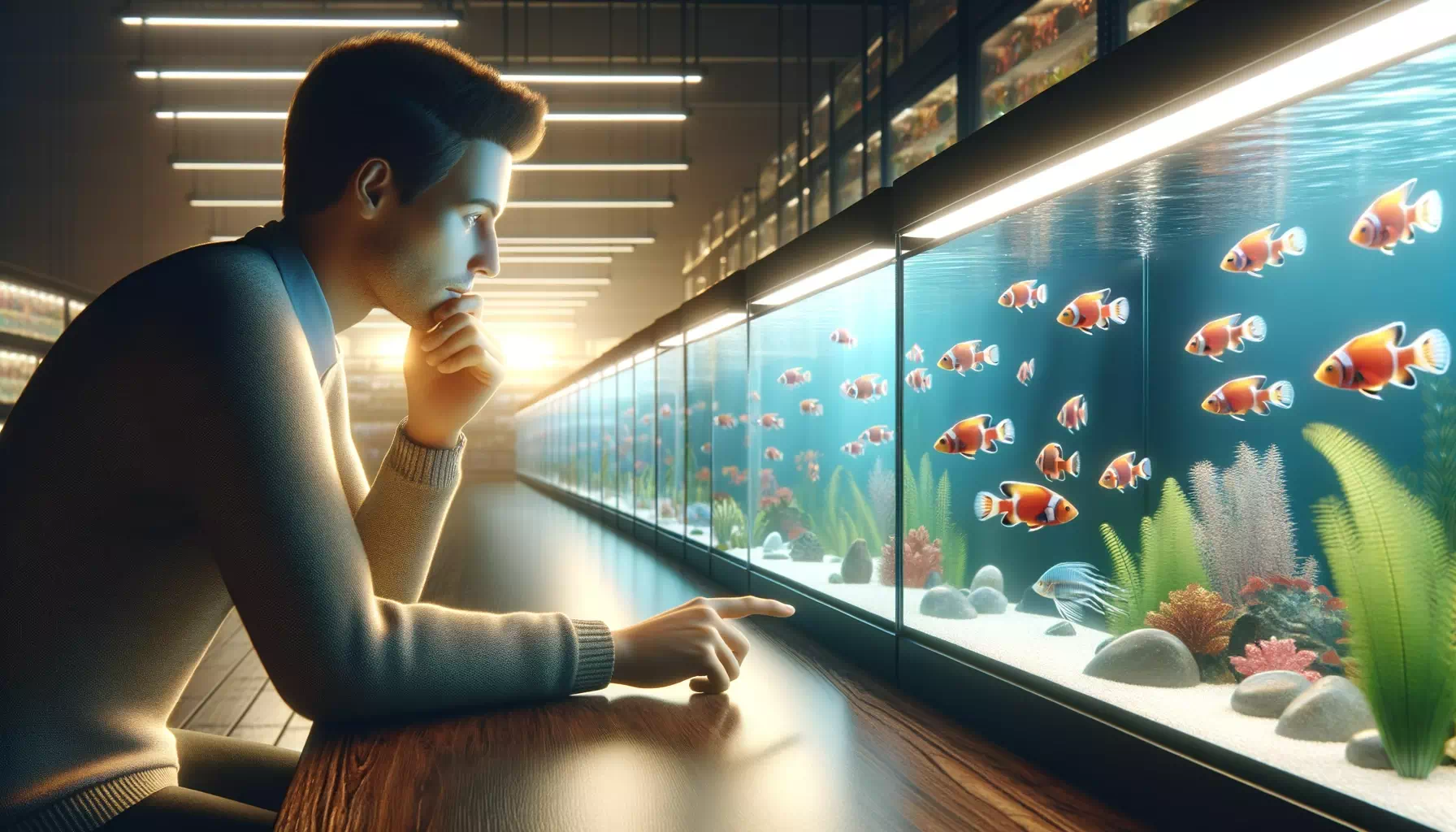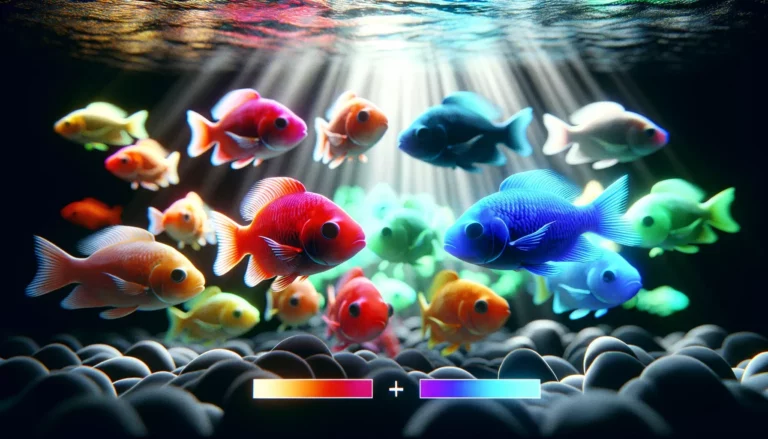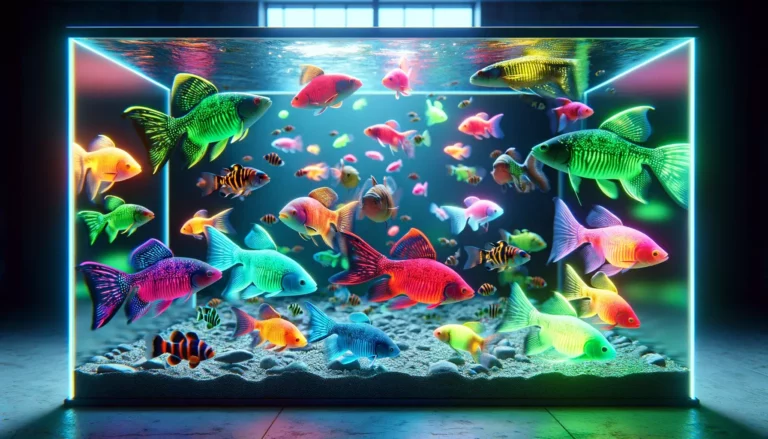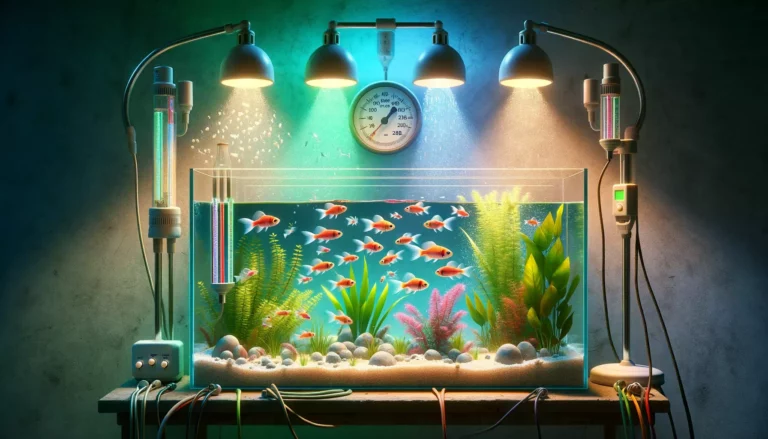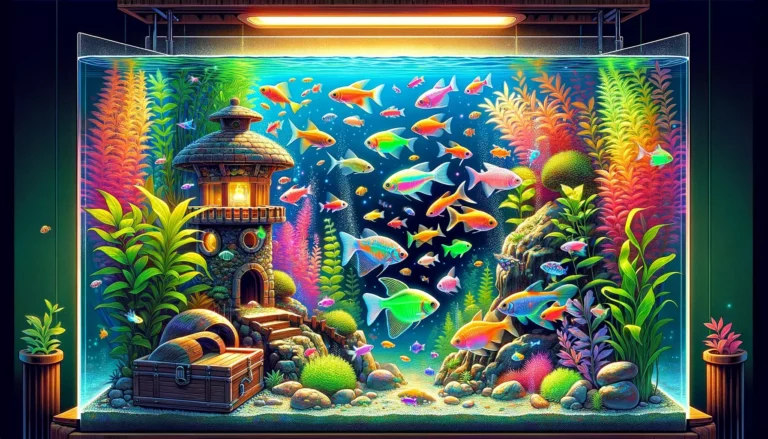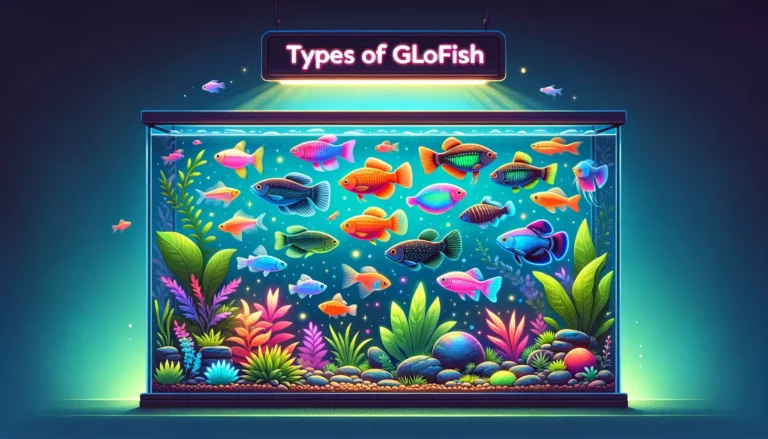Selecting GloFish for a Community Aquarium: Avoiding Problems
Aquariums are a window to an underwater world. They house a variety of fish, including the vibrant GloFish. However, not all GloFish are suitable for community tanks. This article aims to guide beginners on which GloFish species might not fit well in a community aquarium.
Importance of Choosing Suitable GloFish Species for a Community Aquarium
Creating a vibrant community aquarium involves more than just picking colorful fish. The harmony in the tank depends greatly on the compatibility of the species chosen. GloFish, genetically modified to glow under certain lights, add a unique flair to any aquarium. However, their peaceful coexistence with other tank mates is crucial. It’s not just about aesthetics but ensuring a stress-free environment for all inhabitants.
GloFish come in various species, each with distinct behaviors and requirements. For example, some may prefer calmer waters, while others thrive in a more dynamic environment. Additionally, space is a significant factor. Overcrowding can lead to stress, disease, and aggression. Thus, understanding each species’ needs and temperament is vital.
Selecting the right GloFish species ensures a balanced ecosystem in the aquarium. It prevents aggressive encounters and promotes a healthier, more active fish community. Moreover, it minimizes maintenance issues, like excess waste, resulting from stressed or incompatible species. In essence, a well-thought-out selection enriches the visual appeal and the overall health of the aquatic habitat.
Goal of the Article: Identifying Specific Species to Avoid
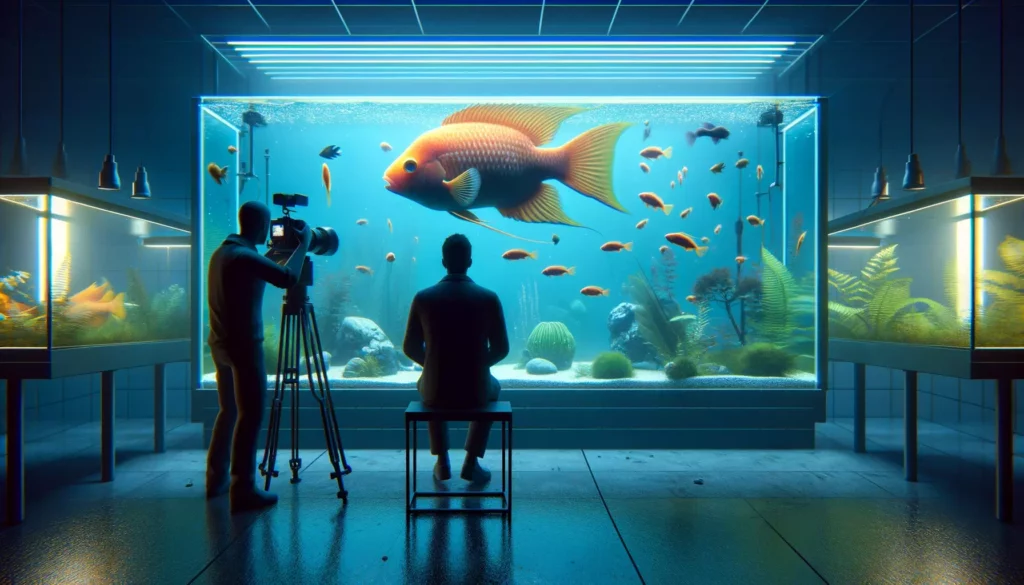
The primary aim of this article is to guide enthusiasts in forming a harmonious GloFish community. Identifying species that could disrupt the tank’s peace is crucial. This knowledge helps in avoiding potential conflicts and ensuring a serene environment for all aquatic life.
Certain GloFish species might exhibit territorial behavior or have specific dietary needs that don’t align well with others. For instance, a species accustomed to a diet of live food might pose a threat to smaller, more passive fish. Also, some GloFish are schooling fish and can become stressed if kept in small numbers, leading to erratic behavior.
This article will focus on the characteristics of GloFish species that are less suitable for a communal setting. It will highlight behavioral patterns, space requirements, and dietary habits that could lead to disharmony in the tank. By understanding which species to avoid, aquarium enthusiasts can make informed decisions, leading to a more vibrant and peaceful aquarium community.
Description of Aggressive GloFish Species
GloFish, though captivating, can exhibit aggression, disrupting the tank’s harmony. Tiger Barbs are a notable example, known for their nippy nature. These vibrant fish can be a handful, especially when they’re not in a sizable group. Tiger Barbs tend to target the fins of slower, long-finned fish, making them less ideal for a peaceful community tank.
Another species, the GloFish Betta, carries the territorial trait typical of traditional Bettas. They prefer solitude and might show aggression towards other fish invading their space. While stunning, their requirement for personal territory can lead to confrontations in a shared tank.
It’s essential to understand these traits when choosing GloFish. While their glowing appearance is enticing, their behavior can lead to stress and injury in a mixed-species tank.
Understanding Aggression and Undesirable Traits
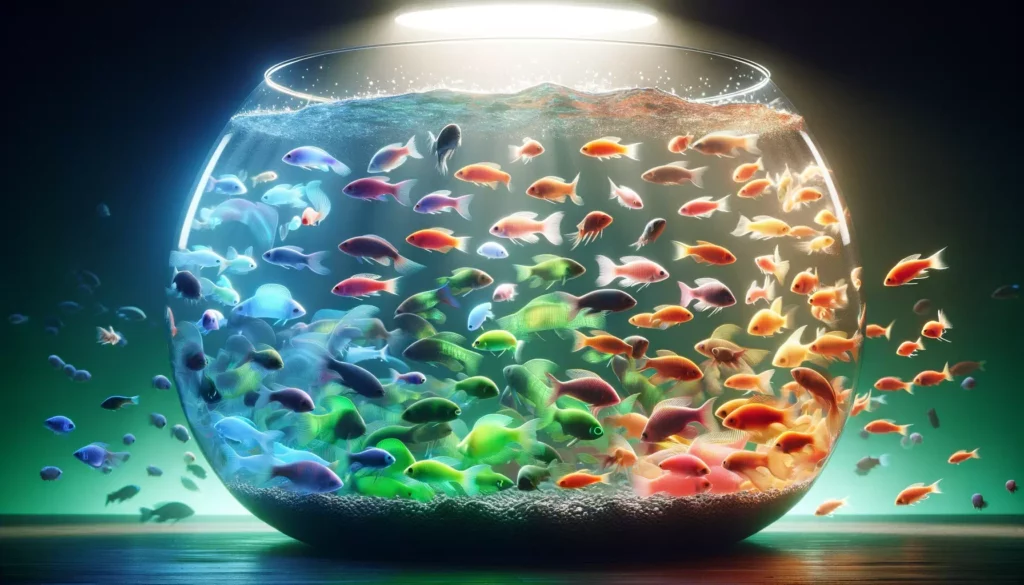
Aggression in fish can stem from various factors. Territorial disputes are common, especially in species like GloFish Bettas. They defend their area vigorously, leading to conflicts if the tank doesn’t provide adequate space or hiding spots.
Competition for food is another aggression trigger. Fish like Tiger Barbs may become dominant during feeding times, intimidating smaller or more passive species. This can result in unequal food distribution and stress among the tank inhabitants.
Furthermore, inadequate schooling can lead to aggression in species like Tiger Barbs. These fish feel secure in numbers. A small group might lead to nervous, erratic behavior, often culminating in aggression towards other tank mates.
Recognizing these behavioral traits is crucial. Aggression can manifest as chasing, nipping, or continuous harassment of certain fish. Monitoring these behaviors helps in managing the tank dynamics, ensuring a peaceful environment for all species.
GloFish Species with Large Spatial Requirements
Certain GloFish species demand more space due to their size or activity level. The GloFish Shark stands out in this category. Despite its name, it’s not a true shark but mimics one in appearance and swimming behavior. These fish can grow relatively large, up to six inches, and are very active swimmers. They require ample room to roam and can become territorial if cramped.
| GloFish Species | Size Potential | Activity Level | Spatial Needs |
|---|---|---|---|
| GloFish Shark | Up to 6 inches | Very Active | Requires ample room to swim |
| GloFish Danios | Moderate size | Highly Active | Need space for rapid swimming |
GloFish Danios are another species that thrive with space. They are highly active and enjoy swimming across the tank at high speeds. A small, confined space can lead to stress and aggressive behavior in these otherwise peaceful fish.
It’s crucial to consider these spatial needs when planning a community tank. Opting for species that require less space can prevent stress and promote a harmonious aquatic environment.
Implications of Limited Space for Large GloFish Species

Keeping large or active GloFish species in a small tank can lead to several issues. Firstly, cramped conditions can induce stress. Fish under stress are more prone to diseases and often exhibit a decrease in color vibrancy, negating the very reason GloFish are chosen.
Territorial behavior is another consequence of inadequate space. Species like the GloFish Shark may become aggressive if they can’t establish their territory. This aggression can result in injuries or even fatalities in the tank, disrupting the peaceful coexistence of species.
Moreover, a small space can limit the natural swimming behavior of active species like the GloFish Danio. This restriction can lead to erratic or hyperactive behavior, unsettling other tank inhabitants and leading to a chaotic environment.
In summary, it’s essential to match the tank size with the spatial requirements of the chosen GloFish species. Doing so ensures the well-being of the fish and maintains the aesthetic and harmonious nature of the community aquarium.
GloFish with Special Water Parameter Requirements
Certain GloFish species are quite particular about their living conditions, demanding specific water parameters to thrive. The GloFish Betta, for example, prefers warmer water, ideally between 76°F and 81°F, and a pH level close to neutral, ranging from 6.5 to 7.5. Keeping the water conditions within this range is crucial for their health and wellbeing.
| GloFish Species | Preferred Temperature Range | Ideal pH Range |
|---|---|---|
| GloFish Betta | 76°F – 81°F | 6.5 – 7.5 |
| GloFish Tetras | 72°F – 78°F | 6.0 – 7.5 |
GloFish Tetras also have precise requirements. They thrive in slightly acidic to neutral water, with a pH range of 6.0 to 7.5. The water temperature should be maintained between 72°F and 78°F. Consistency in these parameters is key to keeping these fish vibrant and active.
Adhering to these specific conditions ensures the fish not only survive but also display their best colors and behaviors.
Challenges in Maintaining Optimal Conditions
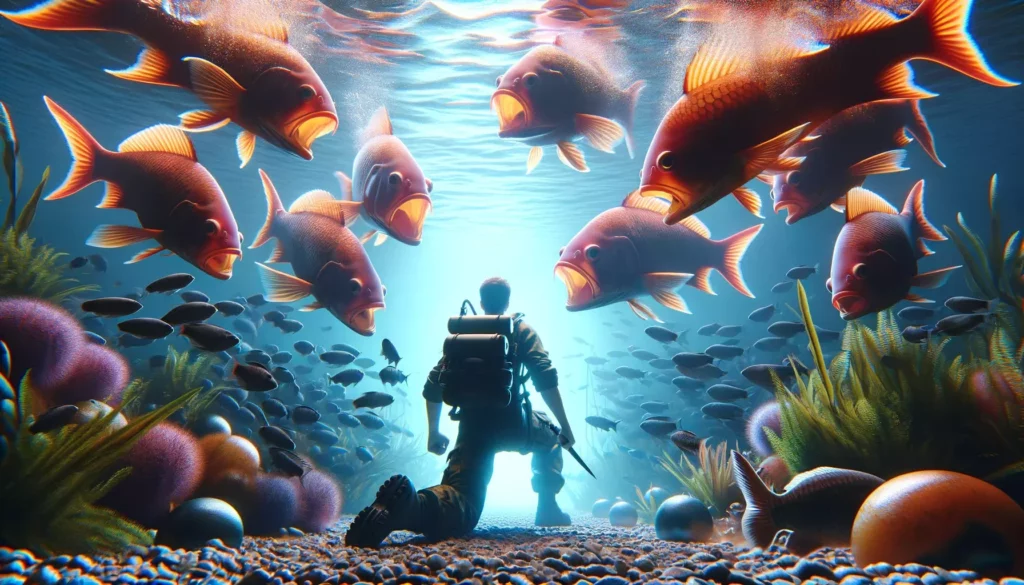
Maintaining the precise water parameters for these GloFish can be challenging, especially in a community tank with species having varied needs. Regular monitoring and adjustment are essential. Fluctuations in pH, temperature, or hardness can stress the fish, leading to health issues or subdued colors.
Balancing the needs of different species in one tank complicates matters. For instance, a species preferring warmer waters may not be compatible with one that thrives in cooler temperatures. Achieving a middle ground without compromising the health of any species requires careful planning and constant management.
Additionally, equipment like heaters, filters, and pH meters become indispensable in such setups. They ensure the environment remains stable but also add to the complexity and maintenance cost of the aquarium.
In conclusion, understanding and catering to the specific water parameter needs of GloFish species is crucial. It ensures the vitality and vibrancy of these unique creatures, making the extra effort in maintaining their environment well worth it.
GloFish with Incompatible Diets
Diet is a critical aspect of fish care, and some GloFish species have distinct dietary preferences that set them apart. GloFish Bettas, for instance, are carnivorous, relying heavily on a protein-rich diet. They thrive on specially formulated Betta pellets, frozen or live food like brine shrimp or bloodworms.
On the other hand, GloFish Tetras are omnivores. They require a balanced diet consisting of both plant and animal-based food. While they do enjoy the occasional brine shrimp or daphnia, their diet should also include high-quality flake food rich in plant materials.
Understanding and catering to these dietary differences is crucial for the health and longevity of these fish.
Challenges of Dietary Incompatibility in a Community Aquarium
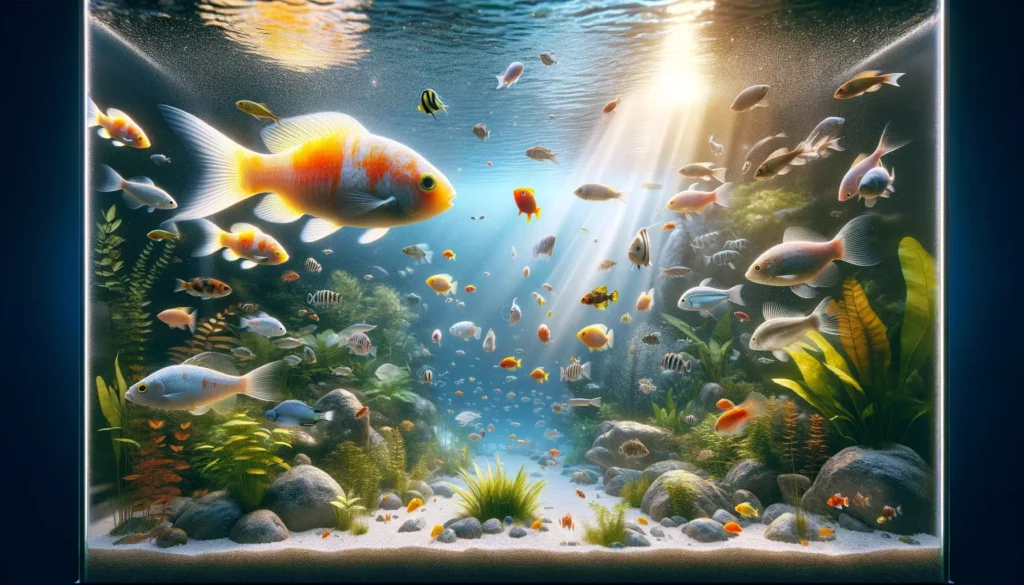
Mixing species with different dietary needs in the same tank can pose significant challenges. One primary issue is ensuring each fish gets the right nutrition. Carnivorous species might consume food meant for omnivores, leaving the latter malnourished. Conversely, if omnivores eat food intended for carnivores, they may miss out on necessary plant nutrients.
Additionally, feeding practices that suit one species might not be ideal for another. For example, Betta fish might prefer to eat from the water’s surface, while Tetras might be more accustomed to foraging for food that sinks. Such disparities can lead to overfeeding or underfeeding, contributing to water quality issues and health problems.
Moreover, the presence of uneaten food, especially when live or frozen food is given, can deteriorate water quality. It can lead to the buildup of harmful substances like ammonia, posing a risk to all inhabitants of the tank.
In summary, maintaining a community tank with GloFish of varying dietary needs requires careful planning and management. Ensuring each species receives the appropriate nutrition without compromising the tank’s overall health is a delicate balance to achieve.
Summary of GloFish Species to Avoid in a Home Community Aquarium
When planning a home community aquarium, certain GloFish species might pose challenges due to their specific needs or behaviors. The Tiger Barb, known for its nippy nature, can harass other fish, especially those with long fins. GloFish Sharks, while impressive in size and appearance, require ample space and can exhibit territorial behavior. GloFish Bettas, although stunning, are solitary and can become aggressive towards tank mates.
Furthermore, GloFish with specific water parameter requirements, like the GloFish Betta and Tetra, demand meticulous attention to pH levels and temperature, which can be challenging to maintain in a community setting. Additionally, dietary needs vary significantly among species. Carnivorous GloFish, like the Betta, have different feeding requirements compared to omnivorous species like the Tetra, complicating communal feeding routines.
Importance of Right Fish Choices for a Harmonious Aquarium Community
Choosing the right fish for a community aquarium is pivotal to ensure a tranquil and healthy environment. Incompatible species can lead to stress, aggression, and even health issues, disrupting the balance of the aquatic ecosystem. It’s not just about the visual appeal; the well-being of the fish is of paramount importance.
| Factor | Significance |
|---|---|
| Temperament | Understanding the temperament of each fish |
| Spatial Needs | Consideration of spatial and territorial needs |
| Water Parameters | Adherence to water parameter requirements |
| Dietary Habits | Acknowledgment of dietary habits for each species |
| Planning | Careful planning based on these factors |
| Harmony | Ensuring natural behavior and peaceful interaction |
| Health | Promoting fish health and overall well-being |
| Enjoyment | Achieving joy and satisfaction in the hobby |
Understanding the temperament, spatial needs, water parameter requirements, and dietary habits of each species is essential. A harmonious aquarium is a result of careful planning and consideration of these factors. It ensures that each fish can exhibit natural behaviors, thrive in their environment, and interact peacefully with their tank mates.
In conclusion, while the allure of GloFish is undeniable, selecting the right species for a community aquarium demands thorough research and understanding. Making informed choices leads to a vibrant, healthy, and harmonious aquatic community, providing immense satisfaction and joy to the hobbyist.
F.A.Q.
Question 1: “Which GloFish species are most commonly unsuitable for a community aquarium and why?”
Tiger Barbs and GloFish Sharks often don’t suit community tanks. Their aggressive and territorial behaviors are problematic. Tiger Barbs are known to nip at fins of other fish. GloFish Sharks, due to their size, require ample space and may dominate smaller fish. GloFish Bettas, although stunning, prefer solitude and can become aggressive, especially towards fish invading their space or resembling another Betta.
When planning a community tank, considering these behaviors is crucial. Incompatibility can lead to stress and injury among tank mates. A harmonious tank requires species with compatible temperaments and space requirements.
Question 2: “Which GloFish species are considered more peaceful and easy to care for?”
GloFish Danios and Tetras are ideal for community tanks. They are known for their peaceful nature and adaptability. These species are not only vibrant but also less prone to aggression. They blend well with various fish, making them a popular choice for beginners.
Care for these species is relatively straightforward. They require standard aquarium conditions and a balanced diet. This simplicity makes them suitable for those new to aquarium keeping.
Question 3: “What should I do if I already have GloFish in a community aquarium, and they start showing signs of aggression?”
First, identify the source of aggression. It might be due to overcrowding, competition for food, or lack of hiding spaces. Observing the tank’s dynamics can provide insights into the cause.
Once identified, you can take corrective measures. These might include rearranging the tank to provide more space, adding more plants or hiding spots, or adjusting feeding routines. In severe cases, separating the aggressive fish might be necessary.
Question 4: “What are common mistakes made by novice aquarists when selecting GloFish for a community aquarium?”
One common mistake is not researching the specific needs of each species. Novices might overlook space requirements or compatibility issues. This can lead to stress and aggression in the tank.
Another mistake is inadequate preparation regarding tank conditions. Not maintaining proper pH levels, temperature, or cleanliness can harm the fish. It’s crucial to understand and meet the needs of the chosen species.
Question 5: “How can I prevent conflicts between GloFish and other fish species in the aquarium?”
Ensure a well-thought-out selection of species. Choose fish with compatible temperaments and similar size. This reduces the risk of bullying or aggression. Providing enough space and resources like food and hiding places is also vital.
Regular monitoring of the tank’s dynamics can help. Notice any signs of stress or aggression early on. Prompt action, like adjusting the tank setup or separating incompatible fish, can prevent larger issues.
